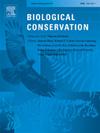Introduction to the special issue: Leveraging genetics in spatial conservation prioritization
IF 4.9
1区 环境科学与生态学
Q1 BIODIVERSITY CONSERVATION
引用次数: 0
Abstract
This special issue sought to stimulate research on the inclusion of intraspecific genetic data and processes into spatial conservation prioritization, which identifies priority areas to implement conservation or restoration actions. The six papers published in this special issue cover terrestrial, freshwater, and marine systems and make use of different molecular markers (mitochondrial DNA, microsatellites and single-nucleotide polymorphisms). They offer good examples of the different conservation objectives that can be pursued by using genetic data; of the use of different molecular markers; and of the techniques needed to spatialize molecular data. They highlight important steps toward operationalizing molecular information to meet conservation goals of having comprehensive, adequate, representative, efficient, and connected protected areas.
求助全文
约1分钟内获得全文
求助全文
来源期刊

Biological Conservation
环境科学-环境科学
CiteScore
10.20
自引率
3.40%
发文量
295
审稿时长
61 days
期刊介绍:
Biological Conservation is an international leading journal in the discipline of conservation biology. The journal publishes articles spanning a diverse range of fields that contribute to the biological, sociological, and economic dimensions of conservation and natural resource management. The primary aim of Biological Conservation is the publication of high-quality papers that advance the science and practice of conservation, or which demonstrate the application of conservation principles for natural resource management and policy. Therefore it will be of interest to a broad international readership.
 求助内容:
求助内容: 应助结果提醒方式:
应助结果提醒方式:


